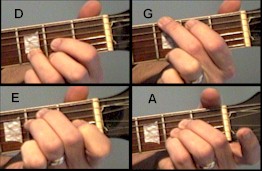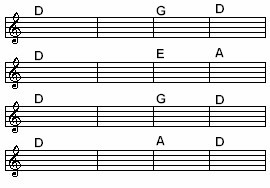Scroll through the lesson and click on notation/video/audio links to load the interactive players.
Please subscribe to get full access to all lessons for only $7.95/month PLUS 1 week free trial.

Riff Interactive lessons are
LESS expensive and
MORE interactive than alternatives!
More Info
|
|

Country Guitar For
Beginners
Lesson 2
Lyle: To get a good country
sound from your electric guitar, try using the bridge pickup, clean
amp setting, splash of reverb, or any steel string
acoustic!
Lyle: This lesson is in the key of D. The main
chords for the key of D are: D, G, and A. These are called the 1 - 4 - 5 chords
in D.
Lyle: In country style music it is very
common to use a II chord. In this key of D, the II chord is Em, the second degree
of the D major scale. We'll change it from a minor chord (Em) to a major chord
(E). Here's all the basic open chords for this lesson:
4
chords

Lyle: You might have learned from somewhere else
that the II chord is always minor. In country style music the II chord is almost
always major, adding an extra "twang" to the sound, or also know as a secondary
dominant.
Lyle: To
get the country style rhythm, I like to use the alternate bass notes. Use all
down strokes for each event in the measure. The alternate bass notes come from
the 5th degree of each chord.
Lyle:
Here's how to play the whole progression using these 4 chords and the alternate
bass rhythm:
Lyle:
This is a very typical chord progression used for the country style. Here's what
the chord progression looks like in a chord chart:
chord
chart

Lyle: Here's a looping jam track for you to play
along with:
Lyle:
When playing lead riffs against country style music you often use major
pentatonic scale patterns. Soloing against the D maj chord you would use the D
maj pentatonic scale for the riffs.
Lyle: This song has four major chords so you'll
want to learn 4 major pentatonic scales:
Lyle:
These are just 1 octave patterns that are movable to any key. I've highlighted
the root notes for each key. There are many other places and patterns to learn
for these scales at a later time.
Lyle: When the chords change like to a G, you
change to the G maj pentatonic scale. Simply follow each chord in the
progression with the correct maj pentatonic scale.
Lyle:
The solo that's in the second half of the lesson sample is made from those scale
positions. There is also a theme or repeating riff during the solo. Here's is
the riff theme for the D chord:
Lyle:
Keep your pinky (4th) finger laying down on the first two strings for this riff.
Notice in measure two there is a pre-bend/release from the 11th fret to the 9th.
Lyle: I
like to use a pick for rhythm guitar, fingers for the country lead style guitar.
Look closely to the video clips and you'll see how I use my thumb for the 3rd
string, my index and middle for the 2nd and 1st strings.
radica: Just
bend the G string and sustain the others right?Lyle:
Yes.
Lyle:
There are a couple other riffs that are mixed up in-between the riff theme.
Lyle:
Here's another riff in the solo you should work on all by itself:
Lyle: Here's another riff with a pre-bend in it
like in the riff theme:
Lyle:
You want to push heavy so that the string/note keeps sustaining. If you push too
light the note might stop ringing as you slide.
Lyle:
Now that you have the riff theme and scale positions and other riffs, here's how
the whole solo goes together:
Michelle: Tough to bend on a plain ol' steel string
acoustic - or else my fingers are still too weak.
Lyle: Most acoustic steel string guitars aren't
meant for bending strings. They are setup with heavy gauge strings for loud
rhythm playing.
Lyle:
Here's a video of this solo:
Lyle:
Country and blues are all mixed together in many of the rock styles. Example,
Jimmy Page from Led Zeppelin uses these basic country riffs all the time in many
of his songs.
Lyle: Notice how all the riffs follow each chord
change.
Lyle: Kind of tricky. In Blues style you just
learn one minor pentatonic scale for the whole tune!
Lyle: In the Country style you get to get a
little more progressive in your delivery of melody and lead
playing.
Michelle: Pick versus finger style - one better than the
other? Or personal preference?
Lyle: I like to use a pick for most everything.
In this lesson I used a pick for the rhythm guitar, and fingers for the lead
guitar.
Lyle: That's all for this lesson, see you at the
next lesson!
|
<< load notation from left
|
|
<< load audio from left
|
<< load audio from left
|